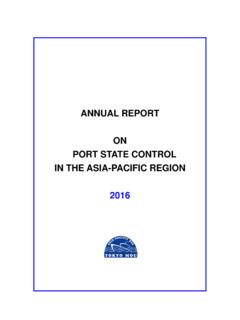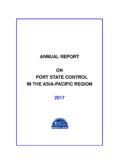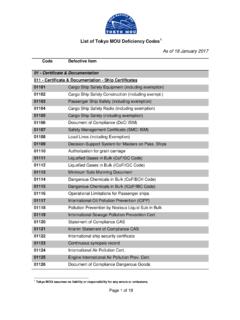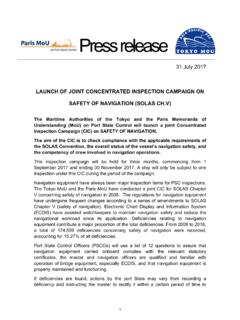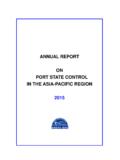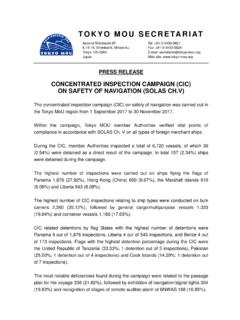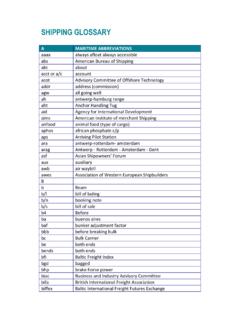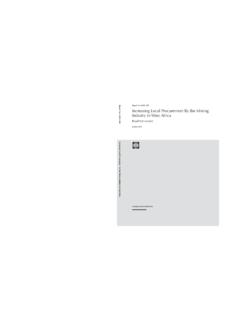Transcription of ANNUAL REPORT ON PORT STATE CONTROL IN THE ASIA …
1 ANNUAL REPORT . ON. PORT STATE CONTROL . IN THE ASIA-PACIFIC REGION. 2013. This work is copyright. It may be reproduced in whole or part subject to the inclusion of an acknowledgement of the source but not for commercial use or sale. Further information may be obtained from: The Tokyo MOU Secretariat Ascend Shimbashi 8F. 6-19-19 Shimbashi Minato-ku, Tokyo Japan 105-0004. Tel: +81-3-3433-0621. Fax: +81-3-3433-0624. This REPORT is also available at Tokyo MOU web-site ( ) on the Internet. memorandum OF understanding ON PORT STATE CONTROL IN THE ASIA-PACIFIC REGION. FOREWORD. We are pleased to present the ANNUAL REPORT on Port STATE CONTROL in the Asia-Pacific Region 2013. The year 2013 is the 20th anniversary of the Tokyo MOU. During the last two decades, the Tokyo MOU has achieved remarkable developments and progress on port STATE CONTROL in the Asia-Pacific region. Taking this opportunity, we wish to thank the Port STATE CONTROL Committee and the Authorities of the Tokyo MOU for the great efforts and contribution made.
2 Furthermore, we would like to congratulate all PSC officers in the region on the dedicated and professional work done. We would like also to express our appreciation to IMO, ILO and other regional PSC regimes for the support and co-operation rendered. This ANNUAL REPORT provides a summary of the port STATE CONTROL developments and activities of the Tokyo MOU in 2013. In addition, the REPORT also includes port STATE CONTROL statistics and analysis on the results of inspections carried out by member Authorities during the year. The Tokyo MOU will make the twenty years achievement as a new start point and take every challenge positively in the years to come. The Tokyo MOU will continue its endeavour and commitment for further enhancement and improvement of PSC activities so as to achieve the ultimate objective of elimination of sub-standard ships throughout the region. Abdul Samad Bin Shaik Osman Mitsutoyo Okada Chairman Secretary Port STATE CONTROL Committee Tokyo MOU Secretariat memorandum OF understanding ON PORT STATE CONTROL IN THE ASIA-PACIFIC REGION.
3 CONTENTS. page OVERVIEW. General introduction .. 1. Review of year 2013 .. 2. The Port STATE CONTROL Committee .. 3. Technical Working Group (TWG) 6. The Asia-Pacific Computerized Information System (APCIS) .. 7. Training and seminars for port STATE CONTROL officers .. 8. Co-operation with other regional port STATE CONTROL agreements .. 11. PORT STATE CONTROL UNDER THE TOKYO MOU, 2013. Inspections .. 13. Detentions .. 13. Deficiencies .. 14. Overview of port STATE CONTROL results 2003-2013 .. 15. ANNEX 1 -- STATUS OF THE RELEVANT INSTRUMENTS .. 22. ANNEX 2 -- PORT STATE INSPECTION STATISTICS .. 25. Statistics for 2013 .. 25. Summary of port STATE inspection data 2011-2013 .. 35. ANNEX 3 -- ORGANIZATION STRUCTURE OF THE TOKYO MOU .. 53. Explanatory Note on the Black-Grey-White Lists 54. memorandum OF understanding ON PORT STATE CONTROL IN THE ASIA-PACIFIC REGION. LIST OF FIGURES AND TABLES. page Figure 1 Inspection percentage .. 16. Figure 2 Port STATE inspections - contribution by Authorities 16.
4 Figure 3 Type of ship inspected .. 17. Figure 4 Detentions per flag 17. Figure 5 Detention per ship type 18. Figure 6 Deficiencies by main categories 18. Figure 7 Most frequent detainable deficiencies . 19. Figure 8 No. of inspections .. 20. Figure 9 Inspection percentage .. 20. Figure 10 No. of inspections with deficiencies . 20. Figure 11 No. of deficiencies . 21. Figure 12 No. of detentions .. 21. Figure 13 Detention percentage .. 21. Figure 14 Comparison of inspections per ship type .. 41. Figure 15 Comparison of detentions per ship type . 41. Figure 16 Comparison of inspections with deficiencies per ship type .. 43. Figure 17 Comparison of number of deficiencies by main categories .. 49. Figure 18 Comparison of most frequent detainable deficiencies 51. Table 1 Status of the relevant instruments 22. Table 1a Status of MARPOL 73/78 .. 24. Table 2 Port STATE inspections carried out by Authorities . 25. Table 2a Port STATE inspections on maritime security .. 26. Table 3 Port STATE inspections per flag.
5 27. Table 4 Port STATE inspections per ship type . 30. Table 5 Port STATE inspections per recognized organization .. 31. Table 6 Deficiencies by categories .. 34. Table 7 Black Grey White Lists .. 35. Table 8 Inspections and detentions per flag . 37. Table 9 Inspections and detentions per ship type .. 42. Table 10 Inspections with deficiencies per ship type .. 44. Table 11 Inspections and detentions per recognized organization .. 45. Table 12 Performance of recognized organization 47. Table 13 Comparison of deficiencies by categories .. 50. Table 14 Comparison of most frequent detainable deficiencies 52. memorandum OF understanding ON PORT STATE CONTROL IN THE ASIA-PACIFIC REGION. OVERVIEW. GENERAL INTRODUCTION the Russian Federation, Singapore, Thailand, Vanuatu and Viet Nam. A maritime Authority which declared the clear intention to fully The ANNUAL REPORT on Port STATE CONTROL in adhere to the memorandum within a the Asia-Pacific Region is published under the three-year period would be accepted as a auspices of the Port STATE CONTROL Committee co-operating member with unanimous consent of the memorandum of understanding on Port of the Port STATE CONTROL Committee.
6 Peru is STATE CONTROL in the Asia-Pacific Region (Tokyo participating in the Tokyo MOU as a MOU). This ANNUAL REPORT is the nineteenth co-operating member Authority at the issue and covers port STATE CONTROL activities moment. and developments in the year 2013. The main objective of the memorandum is to The memorandum was concluded in Tokyo on establish an effective port STATE CONTROL regime 1 December 1993. The following maritime in the Asia-Pacific region through co-operation Authorities in the Asia-Pacific region are the of its members and harmonization of their signatories to the memorandum : Australia, activities, to eliminate substandard shipping so Canada, Chile, China, Fiji, Hong Kong (China), as to promote maritime safety, to protect the Indonesia, Japan, Republic of Korea, Malaysia, marine environment and to safeguard working New Zealand, Papua New Guinea, the and living conditions on board ships. Philippines, the Russian Federation, Singapore, Solomon Islands, Thailand, The Port STATE CONTROL Committee established Vanuatu and Viet Nam.
7 The memorandum under the memorandum monitors and controls came into effect on 1 April 1994. the implementation and on-going operation of the memorandum . The Committee consists of In accordance with the provisions of the representatives of the member Authorities, memorandum , the Authorities which have co-operating member Authorities and signed and formally accepted the observers. The observer status has been memorandum or which have been accepted granted the following maritime Authorities and with unanimous consent of the Port STATE the inter-governmental organizations by the CONTROL Committee would become full Committee: Democratic People's Republic of members. Currently, the memorandum has 19. Korea, Macao (China), Solomon Islands, full members, namely: Australia, Canada, United states Coast Guard, the International Chile, China, Fiji, Hong Kong (China), Maritime Organization (IMO), the International Indonesia, Japan, Republic of Korea, Malaysia, Labour Organization (ILO), the Paris MOU, the Republic of the Marshall Islands, New the Vi a del Mar Agreement, the Indian Ocean Zealand, Papua New Guinea, the Philippines, 1.
8 memorandum OF understanding ON PORT STATE CONTROL IN THE ASIA-PACIFIC REGION. MOU and the Black Sea MOU. The 1969;. Secretariat of the memorandum is located in Tokyo, Japan. the Merchant Shipping (Minimum Standards) Convention, 1976 (ILO. For the purpose of the memorandum , the Convention No. 147);. following instruments are the basis for port STATE CONTROL activities in the region: the Maritime Labour Convention, 2006; and the International Convention on Load Lines, 1966; the International Convention on the CONTROL of Harmful Anti-fouling the Protocol of 1988 relating to the Systems on Ships, 2001. International Convention on Load Lines, 1966, as amended;. REVIEW OF YEAR 2013. the International Convention for the Safety of Life at Sea, 1974, as Year 2013 is the 20th anniversary of the amended; successful conclusion of the Tokyo MOU. A. celebration event was organized in Tokyo the Protocol of 1978 relating to the during the twenty-fourth meeting of the Port International Convention for the STATE CONTROL Committee, where Mr.
9 Ryuji Safety of Life at Sea, 1974; Masuno, Vice-Minister for International Affairs, Ministry of Land, Infrastructure, Transport and the Protocol of 1988 relating to the Tourism of Japan made an opening address;. International Convention for the Mr. Koji Sekimizu, Secretary-General of IMO, Safety of Life at Sea, 1974; as the guest of honor, delivered a key note speech; Mr. Mitsutoyo Okada, Secretary, the International Convention for the Tokyo MOU Secretariat, also made a key note Prevention of Pollution from Ships presentation; and Mr. Mick Kinley, Deputy 1973, as modified by the Protocol of Chief Executive Officer of the Australian 1978 relating thereto, as amended; Maritime Safety Authority (AMSA), representing the member Authorities, Mr. the International Convention on Richard Schiferli, General Secretary of the Standards for Training, Certification Paris MOU Secretariat, representing and Watchkeeping for Seafarers, observers and Mr. Takuya Yoneya, Executive 1978, as amended; Vice President of the Nippon Kaiji Kyokai (ClassNK), representing the industry made the Convention on the International congratulation speeches.
10 The Tokyo MOU is Regulations for Preventing Collisions proud of its great achievement attained in the at Sea, 1972; last two decades. the International Convention on After two years of consideration and Tonnage Measurement of Ships, development, the Tokyo MOU adopted a new inspection regime (NIR) for ship targeting, 2. memorandum OF understanding ON PORT STATE CONTROL IN THE ASIA-PACIFIC REGION. which was scheduled for implementation from inspections, among which 72 or of 2014. In line with the request by the Ministers them were detained as the direct results of the at the 2nd Joint Ministerial Conference of the CIC. The CIC-topic related detention rate is Paris and Tokyo Memoranda to harmonize while the overall CIC detention rate PSC procedures to the highest level between A total of 1,842 CIC related deficiencies the two regions, the Tokyo MOU NIR was were recorded. The most significant developed in the same approach as that of the deficiencies found during the campaign were Paris MOU.
